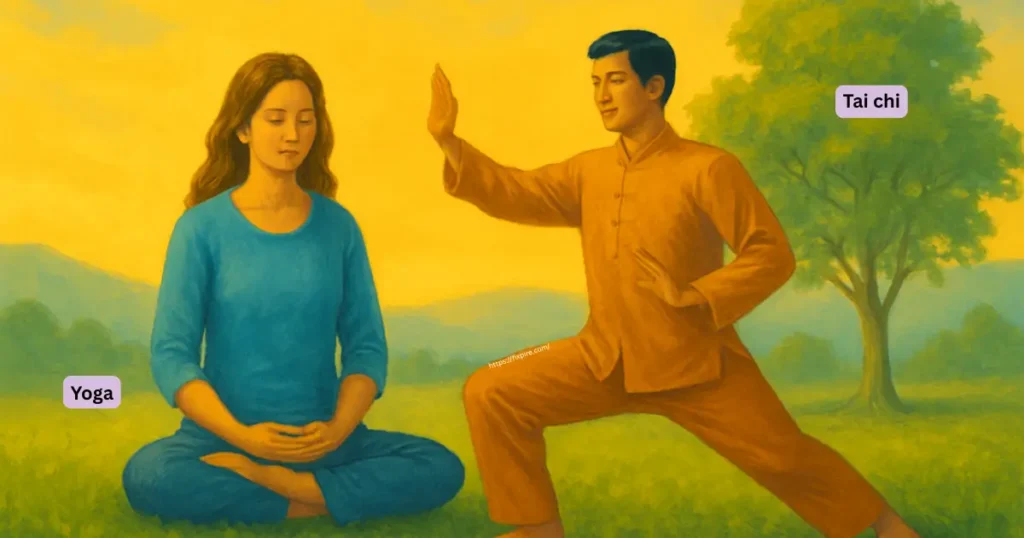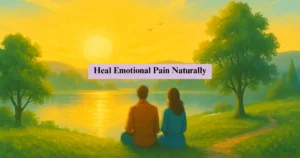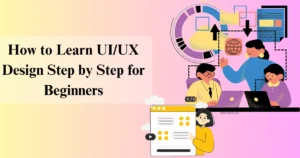Everyone experiences emotional pain at some point in life. Whether it’s from heartbreak, betrayal, loss, or deep disappointment, emotional wounds can hurt just as much—if not more—than physical injuries. Here’s the positive part: healing is truly possible—and you don’t always need medication to start feeling better. In this post, we’ll explore what is emotional pain and how to heal from it naturally without pills. You’ll find simple, science-backed methods that help you feel whole again, one small step at a time.

Understanding What Is Emotional Pain
Before you can begin to heal, it’s important to understand what is emotional pain. Emotional pain refers to the mental suffering or distress caused by experiences like grief, rejection, failure, or trauma. It can feel like sadness, emptiness, hopelessness, or overwhelming anxiety.
Sometimes, it’s triggered by a major life event like losing a loved one or going through a breakup. Other times, it can stem from childhood wounds, low self-worth, or feeling disconnected from others. While everyone feels emotional pain differently, it often shows up in both mental and physical ways—such as insomnia, fatigue, or even body aches.
Why Healing Emotional Pain Naturally Matters
Modern medicine often relies on medication to ease emotional pain. While medication can be helpful in severe cases, it isn’t always necessary—and sometimes, it only masks the symptoms instead of addressing the root cause.
That’s why many people are now turning toward emotional pain healing naturally. Natural healing methods promote long-term well-being and empower you to regain control over your emotional state. Plus, these methods come with fewer side effects and help you build resilience.
Signs You’re Experiencing Emotional Pain
Recognizing emotional pain is the first step to healing. Look for these common signs:
- Constant sadness or tearfulness
- Feeling emotionally numb or disconnected
- Avoiding people or social activities
- Difficulty concentrating or making decisions
- Physical symptoms like headaches or digestive issues
- Feeling like life has lost meaning
Once you identify these signs, you can begin exploring ways to recover from emotional pain naturally.
How to Heal Emotional Pain Without Medication
If you’re wondering how to heal emotional pain without medication, you’re not alone. More and more people are embracing holistic and natural methods to calm their minds and heal their hearts.
Here are ten effective and natural approaches that can help you navigate through emotional suffering and find your path to peace.
1. Acknowledge and Accept Your Feelings
The first and most powerful step is simply this: feel your feelings.
It may sound simple, but it takes courage. Emotional pain becomes heavier when we resist it or pretend it doesn’t exist. When you’re feeling sad, angry, betrayed, or lost—pause. Don’t suppress those emotions. Acknowledge them. Find a peaceful space and allow yourself to fully experience your emotions. You might say to yourself, “I feel hurt, and that’s okay.” This act of self-validation tells your brain that your pain is real and worthy of attention.
Acceptance isn’t about giving in to suffering—it’s about creating space for healing to begin.
2. Talk About It
You don’t have to carry the weight of emotional pain alone. Opening up can be deeply healing. Find a trusted friend, family member, or therapist and share what you’re going through.
Talking out loud organizes your thoughts, gives perspective, and often leads to emotional release. If you’re not ready to talk to someone, journaling is just as powerful. Writing your thoughts and feelings helps you externalize your inner struggles, making them less overwhelming.
Remember: your voice matters, even if it shakes.
3. Practice Mindfulness and Meditation
Mindfulness is the art of being fully present in the moment—without judgment. When emotional pain strikes, our minds often spiral into the past or future. Mindfulness gently brings you back to now, where healing happens.
Even just five minutes a day of mindful breathing or body awareness can ease emotional tension. Meditation allows your nervous system to reset. Apps, guided sessions, or silent sitting can all help you develop this valuable habit. Over time, you’ll notice greater emotional stability and resilience.
4. Move Your Body
Physical movement isn’t just about staying fit—it’s a healing therapy for your mind and soul.
When we’re emotionally stuck, our bodies carry that tension. Exercise helps release endorphins, which are natural mood boosters. You don’t need to hit the gym; simple activities like walking in your neighborhood, stretching at home, practicing yoga, or dancing to your favorite music can lift your spirits.
Allow your body to express and release the emotions you’re holding inside.
5. Prioritize Sleep and Nutrition
A balanced body supports a balanced mind. Sleep is essential for emotional processing and recovery. When you’re sleep-deprived, your ability to regulate emotions decreases. Try to get 7–9 hours of deep, restful sleep each night to support your emotional well-being.
Nutrition plays a major role, too. Nourish your body with real, whole foods like fresh fruits, leafy greens, nuts, seeds, and whole grains.Cut down on sugar, alcohol, and processed foods, which can increase inflammation and worsen mood swings. Hydrate well.
You’re nourishing more than just your body—you’re supporting your emotional health, too.
6. Engage in Creative Expression
Creativity can unlock powerful healing. Emotions don’t always have words, but they can flow through art, music, dance, or storytelling.
You don’t have to be “artistic” to express yourself. Scribble in a sketchpad, hum a tune, write a poem, or paint with your fingers. The act of creating gives your inner pain an external form. It turns pain into purpose, and at times—even into something beautiful.
7. Try Breathwork or Deep Breathing
Breathing is our most basic life function—but when done with awareness, it becomes a healing tool.
Deep breathing activates the parasympathetic nervous system, which signals your body to relax. Try this easy breathing exercise: breathe in deeply through your nose for four counts, hold for four, then slowly exhale through your mouth for four.Repeat this cycle for a few minutes.
Over time, breathwork can reduce anxiety, calm your racing thoughts, and create emotional space.
8. Spend Time in Nature
Nature is one of the world’s most powerful antidepressants—and it’s free. Being outdoors can lift your mood, ease stress, and even help lower your blood pressure.
Take a slow walk in a nearby park. Sit under a tree. Watch birds, clouds, or running water. Let yourself connect to something bigger than your pain. The fresh air, natural light, and rhythmic sounds of nature offer a gentle, grounding presence.
Sometimes, the earth is the best therapist.
9. Use Natural Remedies for Emotional Pain
For centuries, herbs and natural remedies have been used to support emotional well-being. Some gentle and effective natural remedies for emotional pain include:
- Chamomile or lavender tea: Calms the nervous system and helps with sleep.
- Ashwagandha: An adaptogenic herb known to reduce anxiety and balance mood.
- Magnesium: Supports brain function and reduces stress.
Essential oils like bergamot, frankincense, and ylang-ylang: Promote emotional release and calm when used in a diffuser or applied topically.
Always consult a health professional if you’re starting any supplements.
10. Limit Digital Overload
In the digital age, emotional pain is often made worse by constant comparison, overstimulation, and lack of true connection. Social media can serve as both a helpful connection and a heavy distraction.
Be intentional about your screen time. Unfollow accounts that trigger negative feelings. Take regular breaks from your phone. Replace scrolling with something that feeds your soul—reading, journaling, crafting, or daydreaming.
Digital detox creates mental clarity and emotional space for healing.
What Is Emotional Pain and How to Heal: Mind-Body Connection

Your mind and body are not separate—they’re deeply connected in ways that influence your entire well-being. Emotional pain, such as grief, heartbreak, or trauma, doesn’t just affect your thoughts and feelings. It can also show up physically. You might feel fatigue, muscle tension, headaches, or even stomach issues without realizing that emotional stress is the root cause.
This happens because emotional pain activates your nervous system and stress hormones, triggering inflammation and disrupting your natural balance. That’s why healing emotionally also requires caring for the body—and vice versa.
The mind-body connection means that when you take care of your body, your mind benefits too. And when you soothe your emotions, your physical health often improves. This is why holistic practices like yoga, tai chi, and acupuncture are so powerful for healing emotional pain. They don’t just focus on the symptoms—they bring your whole system back into balance.
- Yoga combines movement, breath, and mindfulness to release tension and calm your nervous system.
- Tai chi uses slow, flowing motions that improve body awareness and reduce anxiety.
- Acupuncture stimulates specific points on the body to release blocked energy and promote emotional equilibrium.
Even simple self-care practices—like stretching, breathing deeply, getting a massage, or drinking calming herbal teas—can regulate your mood and help you process emotions more gently.
When you embrace the mind-body connection, healing becomes more natural and sustainable. You’re not just treating the pain—you’re creating harmony from the inside out. And with regular practice, your body becomes a safe place to hold and heal your emotional world.
Spiritual Practices for Deeper Healing
If you’re open to it, spiritual tools can bring powerful emotional relief. Consider:
- Prayer or connecting to a higher power
- Reading uplifting or philosophical texts
- Practicing gratitude daily
- Visualizing light or healing energy in your heart
These practices help you find meaning and connection beyond the pain.
Building a Daily Healing Routine
Consistency is key. Build a simple daily routine with:
- Morning journaling (how you feel and why)
- Movement (stretch, walk, yoga)
- 10 minutes of mindfulness or prayer
- A nourishing meal
- Rest and reflection before bed
This slow, steady rhythm builds emotional strength over time.
When to Seek Help
Natural methods are powerful, but if your emotional pain is overwhelming or ongoing, seek professional support. Therapists, counselors, and support groups can guide you with compassion and tools tailored to your needs. Asking for help is a sign of strength—not weakness.
Conclusion: You Can Heal Naturally
Healing from emotional pain doesn’t happen overnight. But every small step counts. Choosing natural healing approaches allows your heart to recover deeply—not just to get by, but to flourish.
So if you’re searching for ways to recover from emotional pain naturally, start with kindness toward yourself. You’re not broken—you’re healing. And you’re not alone.











